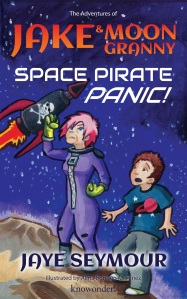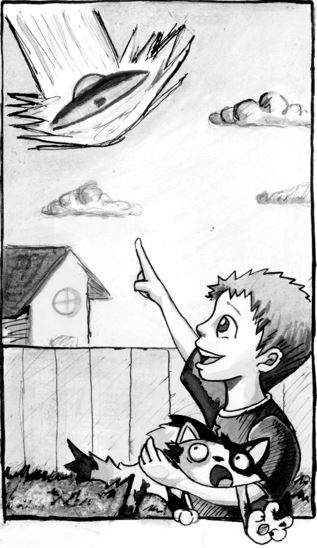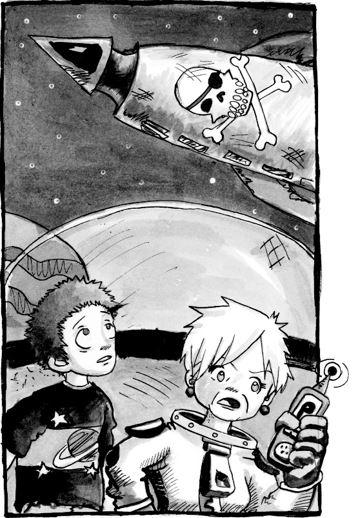 .
.
The Adventures of Jake and Moon Granny: Space Pirate Panic!
by Jaye Seymour
illustrated by Alma Borrego Martinez
978-0-98593783-6 10/10/2013
Age 7 to 9 122 pages
.
“Help! Great Uncle Raymond and his pet fire newt, Flamer, have been kidnapped by te smelliest space pirates in the universe. It’s up to Jake and his granny to rescue them, with a little help along the way from some burping green aliens. But first they’ll need to make it through the spaceship-crunching meteor shower in one piece . . . Will the contents of Moon Granny’s favorite red handbag be enough to defeat Blackbeard and his beastly buccaneers? Or will she and Jake be forced to walk the plank…in space? Hold your noses and burp along with Jake and Moon Granny on their stinky, star-crossing adventure. But whatever you do, don’t press the red button! Or was it the yellow one?!”
Opening
“Jake’s grandmother lived a LONG way away.”
The Story
Bloodthirsty Blackbeard the Bad and his Beastly Buccaneers (pirates) kidnapped Jake’s Great Uncle Raymond. Granny stops by to see Jake and then takes him along in her quest to save her brother. Jake pilots Granny’s spaceship for the first time. In a panic, Jake presses the don’t-ever-touch-under-any-circumstances red button, sending them zooming into space. They finally spot Blackbeard’s bullet shaped spaceship and must somehow get Uncle Raymond and his pet fire newt off the ship. Will they call police or find their own way of rescuing Raymond?
Review
Space Pirate Panic contains the meanest, smelliest pirates in space, a granny who is in charge of alien relations, dust control, and cheese tasting on the moon where she lives. Then there is Jake, age unknown, who wishes he had a “normal” grandmother; one that showed up to school functions, knitted him awful sweaters, hands out pocket money, and he could visit every weekend. Until his granny shows up . . . then he realizes he likes his granny just the way she is. I like that beginning. Jake wants a normal life in comparison to other kids, until he realizes—with granny’s visit—that he has the best grandmother.

The action—and humor—are non-stop once Jake sets off in granny’s spaceship. Jake does get one of his wishes when Swish, the family cat, takes off with Jake’s green space gloves. Granny knits Jake new gloves on the way to Zabalon. Jake pushes a button Granny has just told him not to push, the trip to the Zabalon King goes smoothly, they spot Blackbeard’s ship and . . . well, there is no climatic moment. While there is a struggle, it is rather tame and ends too conveniently. The best part of the ending is the twist, but that is easy to figure out early in Uncle Raymond’s rescue.
I liked Space Pirate Panic but hope in the next book things do not resolve so easily—and quickly—for Jake and Granny. I’d like to know Jake’s age. Maybe things occurring so smoothly was appropriate for his age group. In any case, Space Pirate Panic is loaded with action, the adventure is interesting, the enemy is humorous, and Uncle Raymond can cause trouble, making me think Blackbeard kidnaped Uncle Raymond because of more than a desire for one million moon dollars. It is odd to think an old woman flying a not-top-of-the-line spaceship would have one million moon dollars for a ransom. Then again, the kidnappers are space pirates and dirty ones at that. I can’t wait to read the next book in this unusual space adventure. Kids age 7 to 9 will enjoy Jake & Moon Granny: Space Pirate Panic! This is also a great book for Hi-Low readers.

JAKE & MOON GRANNY: SPACE PIRATE PANIC! Text copyright © 2013 by Jaye Seymour. Illustrations copyright © 2013 by Alma Borrego Martinez. Reproduced by permission of the publisher, Jaye Seymour.
Buy Jake & Moon Granny: Space Pirate Panic at Amazon —Book Depository—ask for at your local bookstore.
—Book Depository—ask for at your local bookstore.
.
Learn more about Jake & Moon Granny: Space Pirate Panic HERE.
Meet the author, Jennifer Moore, aka Jaye Seymour, at her website: http://jennifermoore.wordpress.com/
Meet the illustrator, Alma Borrego Martinez, at her website:
.
.

Filed under:
4stars,
Books for Boys,
Children's Books,
Debut Author,
Library Donated Books,
Series Tagged:
aliens,
Alma Borrego Martinez,
Chapter book,
children's book reviews,
Jaye Seymour,
Jennifer Moore,
knowonder,
Moon Granny,
spaceships,
Zapalon 







If you write for young children, this might be just the ticket for you to get published. Check it out.

knowonder is looking for creatively crafted read-aloud stories, written in 3rd person limited.
The focus and mission of knowonder! magazine is to help parents promote, encourage, and teach creativity, imagination, and literacy to their children.
Their audience is parents and their children between the ages of 3 and 10. We publish 10 fiction stories per month on the web site. Additionally, weThey publish both print and digital collections of stories from the 500 stories available on our web site.
Stories: Story submissions should be fiction. They sometimes accept an occasional non-fiction story but this is the exception, not the rule. They encourage writers to submit stories that are full of action, adventure, and/or fun. They discourage stories that deal with everyday lives of children or present familiar things in a familiar way. They encourage creativity and imagination, and most of all, fun! Each story should be one that a child will love to listen to. Imagery and action are key elements that we strongly encourage.
Story word counts may range between 500 to 2000 words. Call outs are appropriate and do not count toward the total word count. Call out activity ideas or “talk time” ideas are welcome! We are willing to entertain longer stories. We may be willing to accept stories told in rhyme, but have very high expectations for proper meter, etc.
Fiction: We pay $25-50 per fiction story. Each published story is also eligible for the monthly Editor’s Choice Award and a $100 cash prize.
Articles: We are currently looking for volunteers to help us build out this section (fun facts). Please see the submission guidelines for more information on what we are looking for in this category.
for You by You articles: We are currently looking for volunteers to help us build out this section. Please see the submission guidelines for more information on what we are looking for in this category.
Kid Stories: We do not pay anything upfront for Kid Stories or Kid Art, however, we hold a monthly contest and award kids with great prizes each month!
Click here to submit a story. (Note: you will need to create an account with them. It’s quick and painless, and once you’ve done it, you’ll be able to use that account to submit work to lots of other publishers, too).
Before submitting, however, they ask that you please do these two things:
1. Read through our legal agreement. By submitting to us, you acknowledge that you have read and accept our legal terms and agreement.
2. Read our submission guidelines! We have accepted a lot of different stories in the past, but we are narrowing our focus and want you to have the best chances possible of getting your stories published. So please read these guidelines before submitting to make sure you’re sending us something we really want to see.
Here is what they are looking for. This is very good explanation of what makes a good book for this age group. I cut out all the examples from books they provided, but when you have time it is worth studying. Here’s the list:
Narrative stories that are fun, adventurous, engaging, silly, imaginative, creative, have great characters, are memorable, entertaining, flow well when read aloud and have action! Remember, you are sitting by the bedside of the child, you have just enough light to read-aloud. The child’s eyes are closed, or even if they’re open he’s imagining what you are reading. knowonder! wants stories that will paint images in a child’s mind and encourage use of all 5 senses as they imagine amazing visions of their own.
Read-Alouds – knowonder! stories are read-aloud stories.This means that a large majority of stories you submit to knowonder! should be stories that a parent or older child can read out loud to younger children. These are very different in form, format, function (etc.) than picture books. Our stories have just one picture and rely, instead, on imagery created inside the story. In that sense, our stories are much more akin to chapter books and young adult fiction. Therefore, be careful to write stories that aren’t envisioned from the beginning as a picture book.
SDT—This stands for Show-Don’t-Tell and is a well-known method for drawing the reader into a story. Please look it up; research SDT. Then check every sentence to make sure you are following the rules!
Narrative– please don’t eliminate good narrative because you are attempting to Show-Don’t-Tell. Narrative includes telling a story using description and well written prose that allows the child listening to create the pictures in his own mind. Imagery and style come in to play here. Give the child the opportunity to use all of her senses when engaging in the story.
Literary device usage—simile, metaphor, imagery, onomatopoeia, alliteration, hyperbole, and use of idioms are all devices that pull readers into the story, make the story exciting, liven up the characters, and make reading aloud fun and engaging.
Plot—A good story will include a well designed plotting of events that somehow effect the main character. Every word, sentence, and paragraph should be analyzed to make sure it is significant to that plot and moves the story forward.
- Beginning–jump right into the action, in medias res! Remember the children are lying in bed, waiting for the action of the story to begin. Write your beginning in a way that will have them mesmerized so much they’ll quit squirming and listen.
- Middle–remember these pointers– rising action (with action being the operative word here), the main character engaging in some conflict, active voice, and keep moving!!!
- Great endings / tie-backs / punchlines–A well written story will follow the plotting to a point where the action rises to critical mass and Explodes! Then it will come down and have a rap up. Good endings do not fall off cliffs, they have a punch line (not necessarily a funny ha!ha! punchline, although that would be nice) but a great ending that has punch and ties back to the conflict, characterization, repetition, or some other element of the story. Wrap up stories nicely. The last line is the hardest to write for a reason. It takes work to get it just right. (Finding a great ending is like the scene from Sister Act where Whoopie Goldberg punches that young red-headed nun in the stomach and out comes that great high note!!! Ahhhhh!!!)
Words—check your writing for weasel words. Do you overuse the word “that,” or any other word? If you have more than one “that” on a page you should just take them out; I’m sure that you will find that you don’t need them. Also, use a thesaurus!! If you’ve used a descriptive word more than once, look it up in a thesaurus and use a synonym. Also, check your word choice–again use a thesaurus! Thesaurus.com should be your best friend! When writing for children an author must look at every single word. How do the words fit together to make a sentence? How do those sentences flow to create a paragraph? How does each word, sentence, and paragraph come together to paint a picture in the mind of a child?
Repetition—Children giggle when funny things happen in stories; they engage when funny things repeat in stories. I’m not talking about rhyme; I’m talking about rhythm and beat and repetition of lines, actions, etc…. A well crafted story will roll off the reader’s tongue and skip along through the child’s mind.
Characterization—Have you been around children? If not you should spend some time listening to them, seriously eavesdropping! You should talk with them, interact with them, keep a notebook nearby at all times, and jot down what they say and do. Each character in your story should be developed so we can see them, hear them, and understand them. They should be quirky, exceptional, and unique. No two children are the same in the real world so they shouldn’t be the same in fiction either. Characters should be dynamic and well rounded, not static and flat. Static means they don’t change, and flat means boring. Show each character through their actions and traits.
Voice—Dialogue should move the story along and help us hear the voices of the characters, especially the voice of the main character. That voice should be unique, whether it’s sad, happy, spunky, thoughtful, philosophical, or whatever, the words chosen should bring that voice out so we can hear it. The tag-lines should be well written. As our editorial team discussed dialogue, we decided we don’t want too much dialogue in our stories. Remember these are read-alouds. The more narrative prose and the less dialogue the better. Not that we don’t want any dialogue – we just don’t want a story that is 75% dialogue! We are looking for more description, imagery, and narration in between because this lends well toward reading aloud.
Point of View—After careful consideration, we’d really like knowonder! stories to be written in 3rd person. First person is also ok, but not the norm. Also, as I looked through the stories I noticed some of the ones we like best are written in 3rd person omniscient. This style is considered archaic nowadays. But I’ve had to consider why. Third person omniscient allows the author/narrator to step into the mind of every character. The powers that be say this is too confusing for a child. J.R.R.Tolkien and C.S. Lewis wrote in this manner. Even J.K. Rowling steps into this style in some of the Harry Potter books. When interviewed on this, she stated it was necessary to step into the mind of Voldemort on occasion and even into the minds of Hermione and Ron. The important point? It moved the story forward. Sticking with 3rd person limited in the mind of only the main character will be our norm, but occasionally the listener might want to know about the minds of different characters.
Tense—Past tense is best for read-alouds. Please stick to past tense. Novice writers tend to switch tense and point of view. No present tense and no switching tense please!
You are your best critic– Write a first draft. Read it out loud. Look carefully at the beginning, middle, and end. Look at each of these guidelines and see if you can spice up your story before submitting to our editorial department. Rewrite. Revise. Submit. We’ll send suggestions as needed. Our goal is to encourage your own creative genius to blossom. (A note on formatting- Justify flush left, no double spacing, only one space after punctuation. (Word-processing has been allowing for the extra space now for many years).
Didactic stories– Didactic means preachy. A moral can be woven into a story without making it come across as a lecture. Characters should grow naturally out of the choices they make, the events in the stories, and their interactions with other people. We get stories all the time that are obviously written with the express purpose of teaching a lesson. Many of these types of stories will fall flat with children. Should we teach them good values and morals? Can we use literature to teach lessons? Yes, absolutely! But let it happen naturally. Also, because of the nature of what we are (2000 words or less) this can be difficult to do without forcing it. So keep in mind the the main purpose of knowonder! is to make reading fun. It’s more important for children to learn to love reading at this point than it is for us to play parent and try to teach them through the stories we write. Think about fables and parables and how relateable they are.
Click this link to read their full Submission Guidelines to make sure you are not sending in the types of stories that stack their desks. You will also find the Editor’s favorite stories and why. Good luck!
Talk tomorrow,
Kathy
Filed under:
authors and illustrators,
How to,
opportunity,
picture books,
Places to sumit,
submissions Tagged:
Digital Books,
e-boos,
Get Published,
knowonder,
Write for Young Children 

 .
.

—Book Depository—ask for at your local bookstore.




